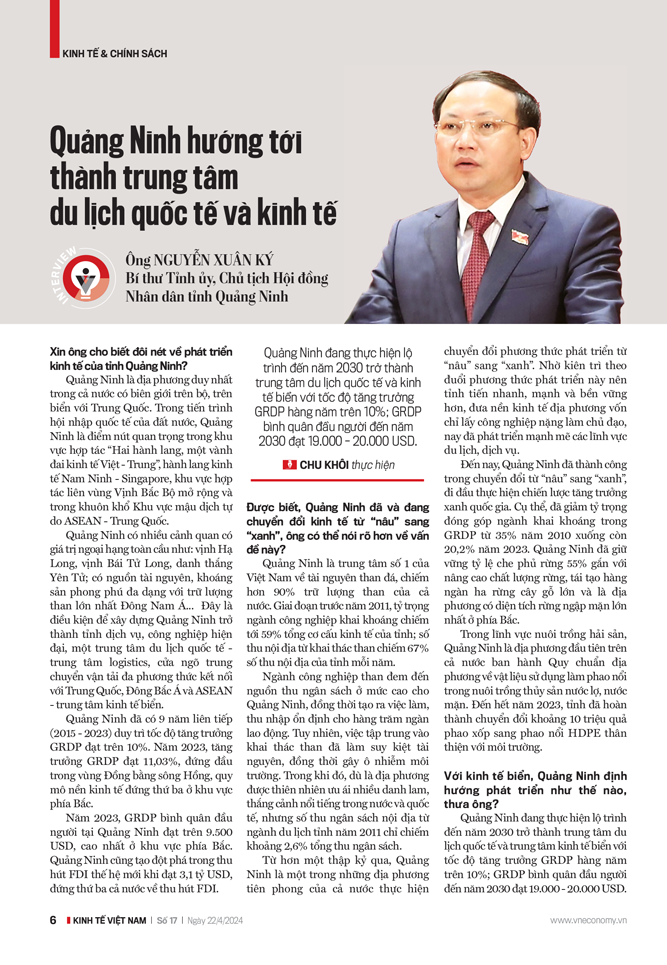Could you please share some information about Quang Ninh’s economic development?
Quang Ninh is the only locality in the country that shares borders with China both on land and at sea. In the country’s international integration process, Quang Ninh is an important node in the cooperation area of the “Two Corridors, One Economic Belt between Vietnam and China”, the Nanning – Singapore Economic Corridor, the expanded Northern Gulf inter-regional cooperation area and within the framework of the ASEAN – China Free Trade Area.
Quang Ninh has many landscapes of paramount global value such as: Ha Long Bay, Bai Tu Long Bay, Yen Tu relic; has abundant and diverse mineral resources with the largest coal reserves in Southeast Asia… This is the condition for building Quang Ninh into a modern industrial service province, an international tourism center – a logistics center, a multimodal transport gateway connecting to China, Northeast Asia and ASEAN – a maritime economic center.
In 2023, Quang Ninh’s GRDP per capita reached over USD 9,500, the highest in the Northern region. Quang Ninh also made a breakthrough in attracting new-generation FDI when it reached USD 3.1 billion, ranking third in the country in terms of FDI attraction.
Quang Ninh has been transforming its economy from “brown” to “green”, could you please elaborate on this issue?
Quang Ninh is Vietnam’s leading center for coal resources, accounting for over 90% of the country’s coal reserves. Before 2011, the proportion of the mining industry accounted for up to 59% of the province’s total economic structure; domestic revenue from coal mining accounted for 67% of the province’s domestic revenue each year.
The coal industry brought in a high level of budget revenue for Quang Ninh, while creating jobs and stable income for hundreds of thousands of workers. However, the focus on coal mining has depleted resources, while polluting the environment. Meanwhile, despite being a locality favored by nature with many famous scenic spots in the country and internationally, the province’s domestic budget revenue from the tourism sector in 2011 accounted for only about 2.6% of total budget revenue.
For more than a decade, Quang Ninh has been one of the pioneering localities in the country to implement the transition from “brown” to “green” development. Thanks to persistent pursuit of this development method, the province has progressed faster, stronger and more sustainably, transforming the local economy, which used to take heavy industry as its mainstay, to now developing the tourism and service sectors strongly.
Up to now, Quang Ninh has successfully converted from “brown” to “green”, and taken the lead in implementing the national green growth strategy. Specifically, the mining sector’s contribution to GRDP has been reduced from 35% in 2010 to 20.2% in 2023. Quang Ninh has maintained a 55% forest cover rate combined with improving forest quality, regenerating thousands of hectares of large timber forests and being a locality with the largest mangrove forest area in the North.
In the field of aquaculture, Quang Ninh is the first locality in the country to issue Local Regulations on materials used for floats in brackish and marine aquaculture. By the end of 2023, the province had completed the conversion of about 10 million foam floats to environmentally friendly HDPE floats.
Regarding the marine economy, what are Quang Ninh’s development orientations?
Quang Ninh is implementing a roadmap to become an international tourism center and a marine economic center by 2030 with an annual GRDP growth rate of over 10%; GRDP per capita by 2030 will reach USD 19,000 – 20,000.
The province determines sustainable development of the marine economy closely linked to the development of comprehensive services that are increasingly playing a leading role, tourism is a spearhead economic sector following the direction of developing a green marine economy, utilizing marine resources in a sustainable way and oceans for economic growth. Developing the marine economy to improve livelihoods and jobs for the people, but must ensure the health of the ocean ecosystem, not trade resources, the environment with tourism growth at all costs.
“With the aim of rapidly increasing the contribution of the marine economy to GRDP, Quang Ninh strives that by 2030, the marine economic sector will account for 25% of the province’s total economy”.
To achieve this goal, Quang Ninh will prioritize synchronous construction and upgrading of the multi-purpose marine economic infrastructure system to ensure “dual benefits” in development. We will reorganize the marine economic development space on the basis of reasonable and scientific zoning based on the ecosystem and according to the function of using sea, islands and coastal areas, ensuring harmonious benefits and reducing conflicts. Developing and sustainably managing the province’s marine economy according to the spatially based marine governance method, interdisciplinary with the substantive participation of local communities, businesses and stakeholders.
In the future, marine mineral exploitation, renewable energy and new marine economic sectors will be developed; mobilizing all resources, diversifying investment forms, accelerating the pace of development and completing seaport infrastructure and seaport services. The province is promoting the development of sustainable tourism, green tourism in a professional, modern, focused and focused way, combined with protecting and maximizing natural advantages, preserving and promoting national cultural identity, cultural values, preserving the landscape and environmental protection.
We are building key tourist centers in Ha Long, Cam Pha, Van Don, Mong Cai, Uong Bi, Co To. The province especially attaches importance to preserving and protecting the World Natural Heritage of Ha Long Bay, Bai Tu Long National Park, Co To Marine Conservation Area, Dong Rui RamSar area…
The content of the article was published in Vietnam Economic Magazine No. 17-2024, released on April 22, 2024. We invite readers to read more at here:
https://postenp.phaha.vn/chi-tiet-toa-soan/tap-chi-kinh-te-viet-nam













